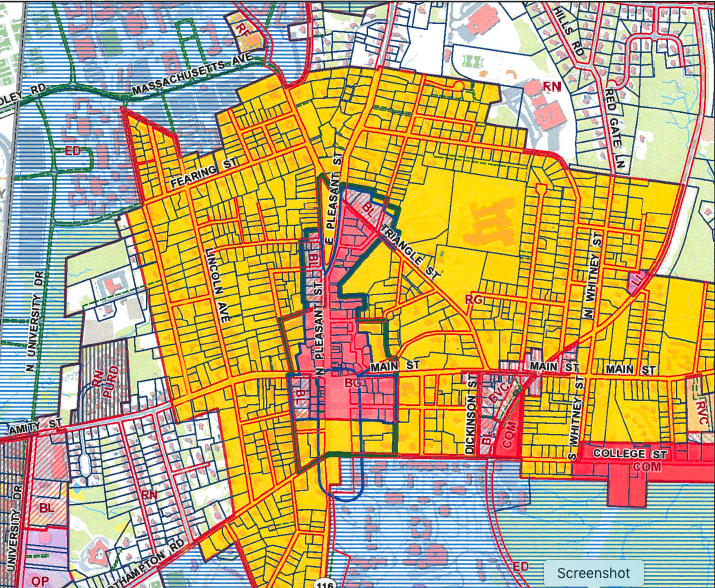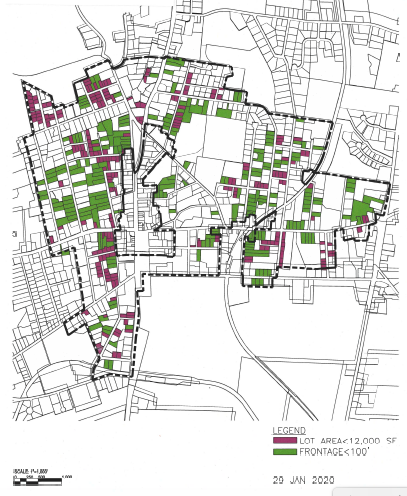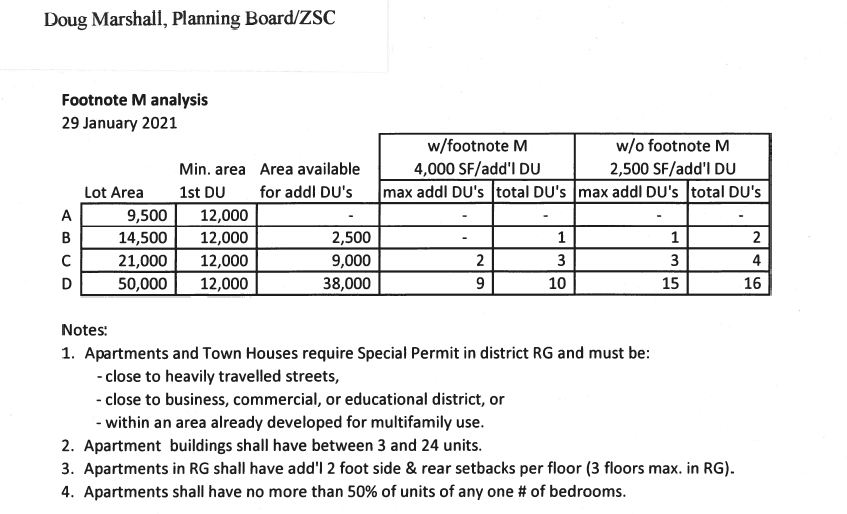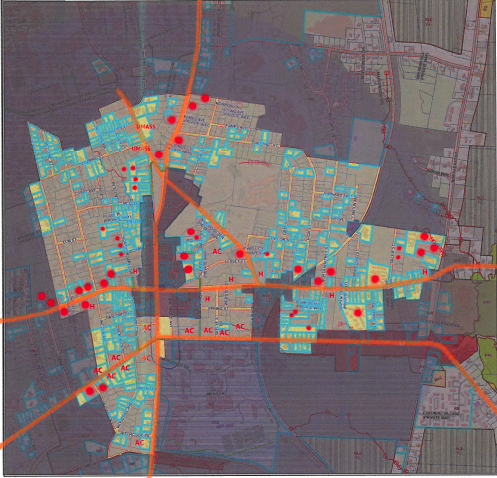Zoning Subcommittee Considers Increased Density In Neighborhoods Near Downtown

Zoning map of downtown Amherst. R-G district in orange, B-G in Pink. Photo: amherstma.gov
Report On The Meeting Of The Zoning Subcommittee Of The Planning Board (2/2/21)
The meeting was held on Zoom and can be viewed here.
Participating: Zoning Subcommittee (ZSC) members: Maria Chao (Chair), Janet McGowan, Doug Marshall, Thom Long. Staff: Town Planner Chris Brestrup and Building Commissioner Rob Morra. Planning Board: Chair Jack Jemsek. Public: Pam Rooney, Town Councilor Cathy Schoen, Hilda Greenbaum, Town Councilor Dorothy Pam
The Planning staff are looking at the rules for apartment buildings, mixed use buildings, inclusionary zoning and zoning standards in the limited business (B-L) district. They are also working on recodification of the bylaw and redoing the flood maps. Morra stated that finishing this work would take quite a bit longer than the March 15 goal set by the Town Council.
Elimination of Footnote m in the General Residence (R-G) District
Footnote m in Table 3 of the Zoning Bylaw states: In addition to the areas required by this table for any existing dwelling units on the lot, the density for new townhouses (Section 3.322) and apartments (Section 3.323) shall not exceed one dwelling unit per 4000 sq. ft. of the remaining lot area, or in the case where there is no existing dwelling units, 4000 sq ft for each new dwelling unit beyond the first unit. Eliminating the footnote would require only 2500 sq. ft. for each additional dwelling unit, which could result in an increase in density from 10 apartments on a one acre lot to 16 units.
Footnote m applies only to the General Residential District (R-G) which is within about a mile of downtown. The minimum lot size for a house lot in the R-G district is 12,000 sq ft, though many structures built before the bylaws were adopted are nonconforming. Footnote m was added by a unanimous vote of the Select Board, Planning Board and Town Meeting in the 1970s after complaints about the construction of Spruce Ridge apartments on High Street as being too dense. It does not apply to duplexes, but does apply to townhouses and apartments.
Marshall and Chao mapped the house lots in the R-G and modeled how many extra dwelling units would be gained by eliminating footnote m. The results were modest with a 14,500 sq ft lot being permitted one extra unit, a 21,000 sq ft lot gaining one extra unit (from 3 to 4), and a 50,000 sq ft lot gaining 6 extra units (from 10 to 16). The colored lots are nonconforming and could not support an extra dwelling unit. Marshall also noted that townhouses and apartment buildings need special permits and must be close to transportation, commercial or educational districts, or in an area with existing multifamily homes.


There are different ways to add units to homes in the R-G. Homes can be subdivided to add 3 units with owner occupancy being required. A house or barn or garage can be converted into up to 4 units if it has the needed lot size and is older than 10 years. The house has to be owner occupied or have a resident manager. One unit can be added, even if there is not the additional lot size, as long as there is no major alteration to the original house. Duplexes are also allowed, as are supplemental dwelling units up to 800 sq. ft. which can be added without any additional lot area and must be owner occupied. The Planning Department talks to developers to help them decide which section of the bylaw to use for their application.
Morra said the major impact of eliminating footnote m would be in duplexes on lots over 22,000 sq ft . Adding a third unit would require there to be a sprinkler system, so it might not be economically viable, but adding 3 units with the elimination of footnote m could make the project more appealing for developers. Units must be a minimum of 350 sq ft.
The biggest effect of eliminating footnote m is on larger lots. A 50,000 sq.ft. (about one acre) lot could go from 10 total dwelling units to 16. This led to a discussion of how many lots in R-G might be affected and whether developers would start buying up smaller lots to combine them and build apartment complexes. McGowan also pointed out that footnote a allows modification of the additional lot area requirement, so eliminating footnote m could result in more than 16 units per acre. ZSC members briefly discussed the impact of increasing density in R-G and its potential impact on the neighborhoods.

Dorothy Pam asked whether the goal of the zoning changes was to create more housing or more affordable housing. In her neighborhood in the R-G district, developers are buying up single family homes and converting them to student rentals which drives up the price of all homes in an area which is already densely settled. Hilda Greenbaum emphasized the need for modestly priced housing in town, which no one seems to be building at this time.
This discussion will be further elaborated on in the work of the Planning Department. The ZSC did not set another meeting date pending the determination of the joint Planning Board and Community Resource Committee meeting the following evening.
Hilda Greenbaum contributed to this article.

Hilda Greenbaum is promoting owner-occupied STARTER homes as now allowed by The Economic Development law signed by
Governor Baker last week. Owning a home allows a person a chance to build equity and a stake in the future of the Town. Tipping the balance of owner-occupied to rental housing–longer term occupants over transient renters–provides stability to the Town. The new law lowers the threshold for projects with affordable units to majority from 2/3 vote of the permitting board.
A correction: Footnote m was added in the 1990s, not the 1970s. It has been instrumental in protecting R-G neighborhoods from overbuilding. What is often left out of the picture of increased density is occupancy. It is not just the building itself that takes up previously unfilled space; it is also the increased activity of comings and goings of new occupants, with their inevitable cars and increase in traffic, as well as the general noise of daily living and, in the case of houses converted to student dwellings, additional and often unpleasant social activities late into the night. We live in a world filled with more and more noise. For now, many residential neighborhoods in Amherst are still a quiet refuge for both homeowners and renters to enjoy. The push for greater density in R-G will bring this to an end.